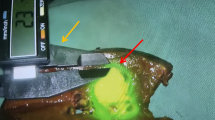Abstract
Objective
The present research aimed to analyze the application of indocyanine green (ICG) fluorescence contrast technique in the resection of hepatoblastoma (HB) in children, and to discuss the use of ICG in the surgery of HB and the value of guidance.
Methods
We retrospectively analyzed the data of 23 children with HB resected using ICG fluorescence contrast technique at the Children’s Hospital of Nanjing Medical University from June 2020 to September 2022, including 16 boys and 7 girls, aged 5 days to 80 months. The patients were administered with an ICG injection of 0.1 mg/kg around 24–48 h before surgery. The surgical margin was detected by real-time fluorescence imaging and confirmed by postoperative pathology.
Results
All primary lesions showed bright fluorescence in 23 HB cases. 22 had clear borders with normal liver tissue, while one neonatal case showed no difference between tumor and background. 13 anatomic resection and 10 non-anatomic resection were performed with ICG fluorescence navigation. The surface of the residual liver was scattered with multiple tumor fluorescence, which was then locally enucleated according to the fluorescence. 22 isolated specimens were dissected and fluorescently visualized. Pathology identified deformed, vacuolated and densely arranged hepatocytes resembling pseudo-envelope changes without tumor residual, due to the compression of the tissue at the site of circumferential imaging.
Conclusion
The ring ICG fluorescence imaging of HB indicates the tumor resection boundary effectively, especially in multiple lesions cases.



Similar content being viewed by others
Data availability
The datasets for this article are not publicly available due to concerns regarding participant/patient anonymity. Requests to access the datasets should be directed to the corresponding author.
Abbreviations
- ICG:
-
Indocyanine green
- HB:
-
Hepatoblastoma
- NIR:
-
Near-infrared
- AFP:
-
Alpha-fetoprotein
- CT:
-
Computed tomography
References
O’Neill AF et al (2017) Characterization of pulmonary metastases in children with hepatoblastoma treated on children’s oncology group protocol AHEP0731 (the treatment of children with all stages of hepatoblastoma): a report from the children’s oncology group. J Clin Oncol 35(30):3465–3473
Meyers RL et al (2017) Risk-stratified staging in paediatric hepatoblastoma: a unified analysis from the children’s hepatic tumors international collaboration. Lancet Oncol 18(1):122–131
Chen H et al (2021) The genetic changes of hepatoblastoma. Front Oncol 11:690641
Kalish JM et al (2017) Surveillance recommendations for children with overgrowth syndromes and predisposition to wilms tumors and hepatoblastoma. Clin Cancer Res 23(13):e115–e122
Sivaprakasam P et al (2011) Survival and long-term outcomes in children with hepatoblastoma treated with continuous infusion of cisplatin and doxorubicin. J Pediatr Hematol Oncol 33(6):e226–e230
Hooks KB et al (2018) New insights into diagnosis and therapeutic options for proliferative hepatoblastoma. Hepatology 68(1):89–102
Choy G, Choyke P, Libutti SK (2003) Current advances in molecular imaging: noninvasive in vivo bioluminescent and fluorescent optical imaging in cancer research. Mol Imaging 2(4):303–312
Frangioni JV (2003) In vivo near-infrared fluorescence imaging. Curr Opin Chem Biol 7(5):626–634
Landsman ML et al (1976) Light-absorbing properties, stability, and spectral stabilization of indocyanine green. J Appl Physiol 40(4):575–583
Yamada Y et al (2019) Fluorescence-guided surgery for hepatoblastoma with indocyanine green. Cancers (Basel) 11(8):1215
Ishizawa T et al (2009) Intraoperative fluorescent cholangiography using indocyanine green: a biliary road map for safe surgery. J Am Coll Surg 208(1):e1-4
Fox IJ et al (1957) A tricarbocyanine dye for continuous recording of dilution curves in whole blood independent of variations in blood oxygen saturation. Proc Staff Meet Mayo Clin 32(18):478–484
Speich R et al (1988) Anaphylactoid reactions after indocyanine-green administration. Ann Intern Med 109(4):345–346
Ishizawa T et al (2014) Mechanistic background and clinical applications of indocyanine green fluorescence imaging of hepatocellular carcinoma. Ann Surg Oncol 21(2):440–448
Cheung TT et al (2018) Pure laparoscopic hepatectomy with augmented reality-assisted indocyanine green fluorescence versus open hepatectomy for hepatocellular carcinoma with liver cirrhosis: a propensity analysis at a single center. Asian J Endosc Surg 11(2):104–111
Wang Z et al (2018) Method for real-time tissue quantification of indocyanine green revealing optimal conditions for near infrared fluorescence guided surgery. Anal Chem 90(13):7922–7929
de Graaf W et al (2011) Transporters involved in the hepatic uptake of (99m)Tc-mebrofenin and indocyanine green. J Hepatol 54(4):738–745
Lake CM et al (2021) Indocyanine green is a sensitive adjunct in the identification and surgical management of local and metastatic hepatoblastoma. Cancer Med 10(13):4322–4343
Alander JT et al (2012) A review of indocyanine green fluorescent imaging in surgery. Int J Biomed Imaging 2012:940585
Narasaki H et al (2017) Intraoperative real-time assessment of liver function with near-infrared fluorescence imaging. Eur Surg Res 58(5–6):235–245
Nakaseko Y, Ishizawa T, Saiura A (2018) Fluorescence-guided surgery for liver tumors. J Surg Oncol 118(2):324–331
Yamamichi T et al (2015) Clinical application of indocyanine green (ICG) fluorescent imaging of hepatoblastoma. J Pediatr Surg 50(5):833–836
Cho YJ et al (2021) The advantages of indocyanine green fluorescence imaging in detecting and treating pediatric hepatoblastoma: a preliminary experience. Front Pediatr 9:635394
Author information
Authors and Affiliations
Contributions
Study conception and design: JZ, TL,QS, Data acquisition: QS, JZ Analysis and data interpretation: QS, JZ, Drafting of the manuscript: QS, JZ Critical revision: TL, JZ.
Corresponding authors
Ethics declarations
Conflict of interest
The authors declare no competing interests.
Additional information
Publisher's Note
Springer Nature remains neutral with regard to jurisdictional claims in published maps and institutional affiliations.
Rights and permissions
Springer Nature or its licensor (e.g. a society or other partner) holds exclusive rights to this article under a publishing agreement with the author(s) or other rightsholder(s); author self-archiving of the accepted manuscript version of this article is solely governed by the terms of such publishing agreement and applicable law.
About this article
Cite this article
Shen, Q., Liu, X., Pan, S. et al. Effectiveness of indocyanine green fluorescence imaging in resection of hepatoblastoma. Pediatr Surg Int 39, 181 (2023). https://doi.org/10.1007/s00383-023-05465-3
Accepted:
Published:
DOI: https://doi.org/10.1007/s00383-023-05465-3




